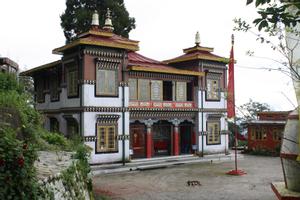Bhutia Busti Monastery
import Media from './components/media'; import { Gallery } from './components/wrappers';
“Darjeeling's other two Buddhist temples stand on the eastern slope of the long mountain ridge on which the town is built. The largest of the temples is situated in the middle of the poor quarter of Bhutia Basti, the 'Tibetan Village', as this part of Darjeeling is called. A steep path runs down to the temple, past a large white reliquary reputed to contain the mortal remains of a Sikkimese queen. Here the rain had wrought the greatest havoc. Many of the wretched huts in the vicinity of the temple had collapsed. Numbers of their occupants still lay buried under thick layers of mud and rubble. Only the temple had been spared by the unleashed forces of nature. So this was the shrine from which Darjeeling takes its name. At one time it used to stand on Mahakala Hill. But the nocturnal din of the lama orchestra disturbed the British, who had the temple demolished and rebuilt farther down the mountainside. It belongs to the Karmapa sect, one of the least known orders of Tibetan Buddhism. There were for merly fourteen hierarchs at the head of this sect. Images of them decorate the great hall of the temple, which is on the first floor. On the ground floor is a room in which are stored various masks worn by the priests during their religious dances: blue and red demons' faces with a tiara of five human skulls, as well as heads of the legendary bird Garuda, a sea monster and a stag with long antlers to which are attached a number of small prayer-streamers.”
[Nebesky-Wojkowitz, René von. 1957a. Where the Gods Are Mountains: Three Years among the People of the Himalayas. Translated by Michael Bullock. New York: Reynal and Company, 37–38]


































































































